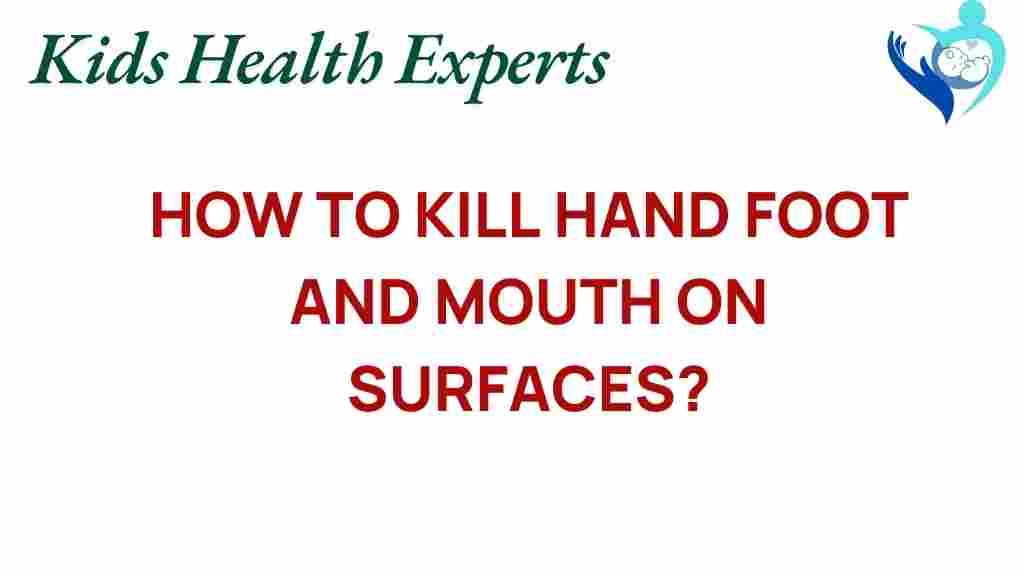Unveiling the Secrets: How to Eliminate Hand, Foot, and Mouth Disease from Surfaces
Hand, foot, and mouth disease (HFMD) is a common viral infection that primarily affects children but can also impact adults. Recognizing how to effectively disinfect surfaces to prevent the spread of this illness is crucial for maintaining health and hygiene. In this article, we will explore the best practices for eliminating hand, foot, and mouth disease from surfaces, ensuring cleanliness and reducing the risk of infection.
Understanding Hand, Foot, and Mouth Disease
Hand, foot, and mouth disease is caused by viruses from the enterovirus family, with coxsackievirus being the most common culprit. The disease is characterized by fever, mouth sores, and a rash on the hands and feet. It spreads easily through direct contact with infected individuals or contaminated surfaces.
To effectively combat this viral infection, understanding its transmission is essential. The virus can survive on various surfaces for extended periods, making proper hygiene and disinfecting practices critical in preventing outbreaks.
Importance of Hygiene in Preventing HFMD
Maintaining proper hygiene is the first line of defense against hand, foot, and mouth disease. Implementing rigorous cleaning and disinfecting protocols helps to reduce the risk of illness, especially in environments like schools, daycares, and homes with young children.
- Encourage regular hand washing with soap and water.
- Use hand sanitizers when soap is unavailable.
- Teach children to avoid touching their face, especially their mouth and eyes.
Step-by-Step Process to Disinfect Surfaces
To eliminate hand, foot, and mouth disease from surfaces, follow these steps:
Step 1: Gather Your Supplies
Before beginning the cleaning process, gather the necessary supplies:
- Soap and water
- Disinfectant wipes or sprays (make sure they are effective against viruses)
- Gloves and masks (optional, but recommended for safety)
- Clean cloths or paper towels
Step 2: Clean the Surface
Start by cleaning the surface to remove dirt and grime. This step is essential, as disinfectants work best on clean surfaces. Use soap and water with a cloth or sponge to wipe down the area thoroughly.
Step 3: Disinfect the Surface
Once the surface is clean, apply a disinfectant. Follow the manufacturer’s instructions regarding contact time to ensure the disinfectant can effectively kill the virus.
- Spray the disinfectant liberally on the surface.
- Let the disinfectant sit for the recommended time.
- Wipe the surface with a clean cloth or paper towel.
Step 4: Focus on High-Touch Areas
Pay special attention to high-touch areas where the virus is likely to spread. These include:
- Doorknobs and handles
- Light switches
- Countertops and tabletops
- Toilets and sinks
- Playground equipment
Step 5: Dispose of Cleaning Materials Safely
After cleaning and disinfecting, ensure that all cleaning materials are disposed of properly. If you used gloves, remove them carefully and wash your hands thoroughly afterward.
Step 6: Maintain Regular Cleaning Routines
Regular cleaning and disinfecting should be part of your routine, especially during peak HFMD seasons. Establish a cleaning schedule to ensure surfaces are treated consistently.
Troubleshooting Tips for Effective Disinfection
Sometimes, despite our best efforts, we may encounter challenges when trying to disinfect surfaces. Here are some troubleshooting tips:
1. Choosing the Right Disinfectant
Not all disinfectants are created equal. Ensure the product you choose is effective against the viruses that cause hand, foot, and mouth disease. Look for EPA-registered disinfectants with labels stating their effectiveness against enteroviruses.
2. Avoiding Common Mistakes
Avoid common mistakes that can reduce the effectiveness of your cleaning efforts:
- Don’t rush the process; give disinfectants the necessary contact time.
- Don’t mix different cleaning products, as this can create harmful fumes.
- Ensure proper ventilation in the cleaning area.
3. Educating Others
Make sure that everyone involved in cleaning understands the importance of these practices. Educate family members, caregivers, and children about hand hygiene and the significance of keeping surfaces clean to prevent illness.
Conclusion: The Path to Prevention and Cleanliness
Hand, foot, and mouth disease can pose a significant health risk, especially for young children. However, by implementing effective hygiene practices and thorough disinfecting protocols, we can significantly reduce the likelihood of transmission. Maintaining cleanliness in your environment is essential for preventing the spread of this viral infection.
Remember, the key to prevention lies in regular cleaning, proper technique, and educating those around you. For more information on health and hygiene, visit CDC’s Guidelines on Handwashing.
By taking these steps, you can help ensure a healthier, safer environment for everyone. Prioritize your health and the health of your loved ones by making cleanliness and hygiene a daily commitment.
This article is in the category Care and created by KidsHealthExperts Team

1 thought on “Unveiling the Secrets: How to Eliminate Hand, Foot, and Mouth Disease from Surfaces”